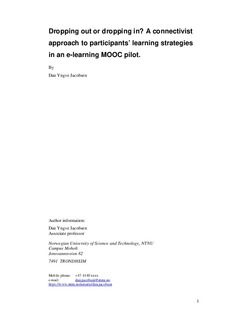Dropping out or dropping in? A connectivist approach to understanding participants’ strategies in an e-learning MOOC pilot
Journal article, Peer reviewed
Accepted version
Permanent lenke
http://hdl.handle.net/11250/2498333Utgivelsesdato
2017Metadata
Vis full innførselSamlinger
Sammendrag
Targeting faculties and external mentors in the teacher-training unit, The Norwegian University of Science and Technology in Trondheim, Norway opened up a Massive Open Online Course (MOOC) pilot on digital learning in the fall of 2014. A main objective was to encourage these to use digital media more actively and hence, also to become role models for their own students’ future digital practice. However, research has shown that a main concern with MOOC programs is attrition. In line with those findings, and according to the course platform data, none of the MOOC participants completed the course material. As the course progressed, less and less pages were opened and obligatory assignments were only rarely submitted. The participants may thus be described as dropouts. Five of these participants were then interviewed about their MOOC experiences and activities. The interviews were transcribed and analyzed according to Grounded theory procedures. A general finding was that the informants would in fact put some of the material and ideas from the MOOC to use. Even if they dropped out, this indicates a gain from the course. In fact, some of the material that was introduced significantly changed these informants’ digital practices when they tested out new ideas in their own teaching. Frame-factors, such as lack of financial compensation or a nonstop flow of competing tasks, however, led the informants to down-prioritize the formal demands in the MOOC pilot. The informants selectively picked the material that suited their own purpose and therefore qualified as “drop-ins” rather than “drop-outs”. Rather than quitters who could not keep up with the pace in the MOOC we met media literate participants who remixed and redefined the MOOC content into a Web 2.0 resource and a stepping stone for self-directed online learning.
